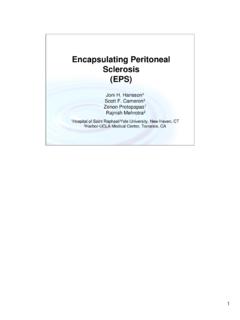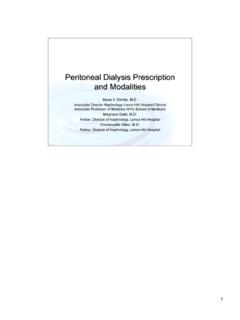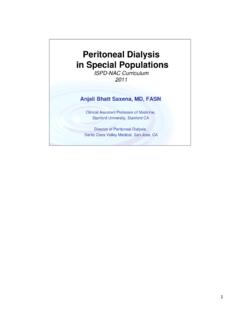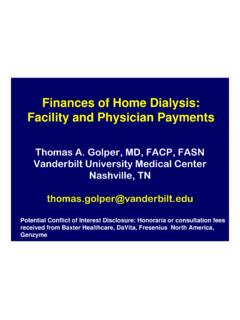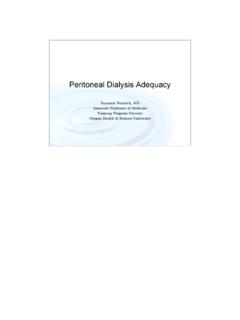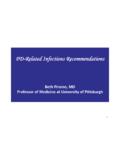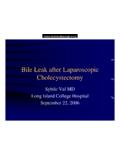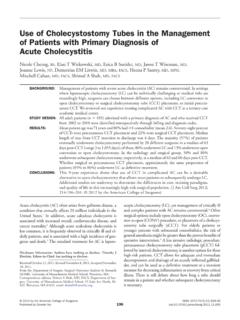Transcription of Non-Infectious Complications of Peritoneal Dialysis
1 Non-Infectious Complications of Peritoneal DialysisPD Curriculum SeriesNorth American Chapter of the ISPDJ oanne M Bargman MD FRCPCJ oanne M Bargman MD FRCPCP rofessor of Medicine, University of TorontoProfessor of Medicine, University of TorontoDirector, Home Peritoneal Dialysis Unit Director, Home Peritoneal Dialysis Unit University Health NetworkUniversity Health NetworkOutline Increased Intra-Abdominal Pressure and Its Consequences Hernias Abdominal and Genital Leaks Hydrothorax Hemoperitoneum and Other Causes of Coloured Dialysis EffluentMr C Gets a Lump48 year old man with polycystic kidney disease is trained on cycler Dialysis . Current prescription is L X 4 exchanges over 8 hours at night, with L day dwell one year later: he is doing well residual renal GFR is 8 ml/minMr C Gets a Lump (cont d) at clinic, he reports a new lump in his left groin. He had been gardening and felt a pop and some tenderness in the groin on physical exam, there is a lump in his left inguinal areaMr C and his LumpIncreased Intra-abdominal Pressure (IAP) instillation of dialysate into the Peritoneal cavity leads to increased IAP the magnitude of the increase depends upon:-volume of dialysate instilled-position of the patient (sitting>standing>supine)-age, body mass index-coughing, lifting, straining at stoolIntra-Abdominal Pressure (IAP), Position & Dialysate VolumeIAPIAP(mmHg)(mmHg)VOLUME OF DIALYSATE (L)VOLUME OF DIALYSATE (L)1230sittingstandingsupineafterTwardow skiHerniasClinical Presentation: lump or swelling that may be tender bowel incarceration or strangulationOther Hernias.
2 Ventral HerniasUmbilical HerniaBiggest risk forBiggest risk forincarcerationincarceration60 year old woman on PD presents with localized abdominal painHernias (cont d)Treatment: warn patient about signs of incarceration surgical repair:- Dialysis around repair depends on renal function and condition of the patient-don t usually have to put them on HD !-reintroduce PD with low volumes, supine posture, increase volume over 2 weeksSo What Happened to Mr C? continued night cycler Dialysis dry during day (RRF 8 ml/min) elective hernia repair no PD for 2 days back to night cycler volume X 2 weeks, 2 Lvolume X 2 weeks, then L volume day dwell re-introduced 2 months laterAbdominal Wall and Genital EdemaPresentation: abdominal swelling or bogginess, scrotal or labial edema diminished effluent return weight gain without peripheral edema pericatheter leak: wetness or swelling at exit siteAbdominal Wall & Genital EdemaDiagnosis: physical exam (have patient stand in front of you) unchanged PET results CT scan pericatheter leak: ultrasound around exit siteAbdominal Wall and Genital EdemaDiagnosis by CT Scanning.
3 Add 100-150 ml Omnipaque to Dialysis bag infuse dialysate into patient have patient ambulatory for 30 to 60 minutes to increase intra-abdominal pressure send for CT scan - discuss with the radiologistCT Dye Dissecting through tunicavaginalisinto scrotal wallCT Scan with IP Dye Demonstrating Leak through HerniaAbdominal Wall & Genital EdemaManagement: reintroduce low pressure PD (eg APD with low volumes) temporary HD to allow healing Abdominal wall: CT scan for occult hernia Genital: CT scan for patent processus vaginalis, which is easily repairedAbdominal Wall & Genital EdemaDiagnosis Careful clinical exam, with the patient standing CT scanning with IP dye In case of dye allergy T2-weighted MRI (no Gd necessary: the dialysate is its own tracer)Early-Onset Shortness of Breath in a PD PatientFM is a 61 year old woman with IgA nephropathy and progressive renal insufficiency.
4 A PD catheter was week after training she calls the unit that she has become progressively short of breath over the past 3 days. There is no cough, wheeze or sputum production. She is 1 kg above her target Gets SOBH ydrothoraxDefinition:The presence of Peritoneal Dialysis fluid in the pleural cavityIncidence:Probably < 5%Pathogenesis:Movement of dialysate, under increased intra-abdominal pressure, from Peritoneal to pleural cavity through congenital or acquired defects in the diaphragmHydrothorax (cont d)Presentation: may be asymptomatic shortness of breath no improvement with hypertonic dialysate diminished effluent return right-sided pleural effusion on CXRH ydrothoraxDiagnosis: thoracentesis for relief of symptoms and/or diagnosis pleural fluid analysis:-transudate- high glucose concentration (usually, but not always)-cell count variableHydrothoraxTreatment: thoracentesis may be helpful if very SOB stop PD temporary hemodialysis, if Dialysis necessaryHydrothoraxTreatment trial of re-introducing low pressure PD (the dialysate in pleural cavity may have functioned as a sclerosing agent) pleurodesis (talc, tetracycline, bleomycin, autologous blood) operative or pleuroscopic repair (diaphragmatic defects identified and patched or oversewn)Dialysate from an Asymptomatic 26 year old WomanHemoperitoneumDefinition: Bloody Peritoneal effluentPresentation: scary !
5 (not as bad as it looks) must consider benign and serious causesHemoperitoneum (cont d) Benign Causes: menstruation ovulation ruptured renal or ovarian cysts trauma coagulopathyHemoperitoneum (cont d)Serious Causes: ischemic bowel colon cancer pancreatitis encapsulating Peritoneal sclerosis urologic cancerHemoperitoneum (cont d)Treatment: IP heparin to avoid clotting of catheter flushes dialysate at room temperature investigations depend on whether benign or serious type of presentationDuring training, warn females in advance of this complicationAnd What Do You Think About This?Chyloperitoneum Drainage of chyle into the Peritoneal cavity Comes and goes depending on dietary fat intake Effluent cell count is normal but triglycerides are high Patients should be investigated for underlying intra-abdominal pathology Treatment should include diet of small and medium chain fatty acidsAnd This?
6 Bile in the Dialysis Effluent The effluent bag on the left has green discolouration due to bilious drainage This implies disruption of the biliary system and can rarely be seen after laparoscopic cholecystectomySummary Points (I) hernias are unsightly, enlarge with time, and pose a risk for leaks and incarceration they can usually be repaired operatively without putting the patient on hemodialysis patients at risk should be on a low pressure PD regimenSummary Points (II) edema of the abdominal wall and genitals is through a leak of dialysate often this resolves with low pressure Dialysis fixed defects, such as hernias or patent processus vaginalis should be surgically repaired (and usually patient can stay on PD through the repair)Summary Points (III) it is important to be aware of hemoperitoneum commonest cause of hemoperitoneum is menstruation, and is benignQuestion 1 One of your PD patients has noted diminished effluent volume and increased abdominal girth.
7 Which one of the following statements best suggests that the cause is a leak of Dialysis fluid? 4 hour, PET shows D/P 4 hour, PET shows D/P rapid in-and-out exchange shows slow scan with IP dye shows dye in the tissue plane outside of the Peritoneal patient has a failed kidney transplant and is still on 2 A patient with PCKD has been on PD for 2 years and has an umbilical hernia. He does not want it repaired. Which of the following statements is most correct? the hernia enlarges, there is an increasing risk of bowel the hernia is intraperitoneal, there is little risk of Dialysis leak through the patient will not be able to receive a renal allograft unless the hernia is bowel strangulation supervenes, PD can be continued but with appropriate antibiotic there is residual renal function, the patient could do APD with day dry or lower day dwell 3A 62 year old woman on PD for 2 weeks develops shows a large right pleural effusion.
8 Which of the following statements is most correct? pleural fluid glucose should be at least 200 mg/dl higher than a simultaneous blood pleural fluid should be a pleural fluid PD should have > 100 X 10 9WC and > 50% is more common for PD hydrothorax to be is more common for PD hydrothorax to occur in male patients > 60 years JMMechanical Complications of Peritoneal Dialysis , inHandbook of Dialysis , 4thEdition (2007)Lippincott Williams & Wilkinspp KM et alManagement Options for Hydrothorax Complicating Peritoneal DialysisSemin Dial 2003; 16: JMNon- infectious Complications of Peritoneal Dialysis , inTextbook of Peritoneal Dialysis , 2ndedition (2000)Kluwer Academic Publisherspp 609-646
